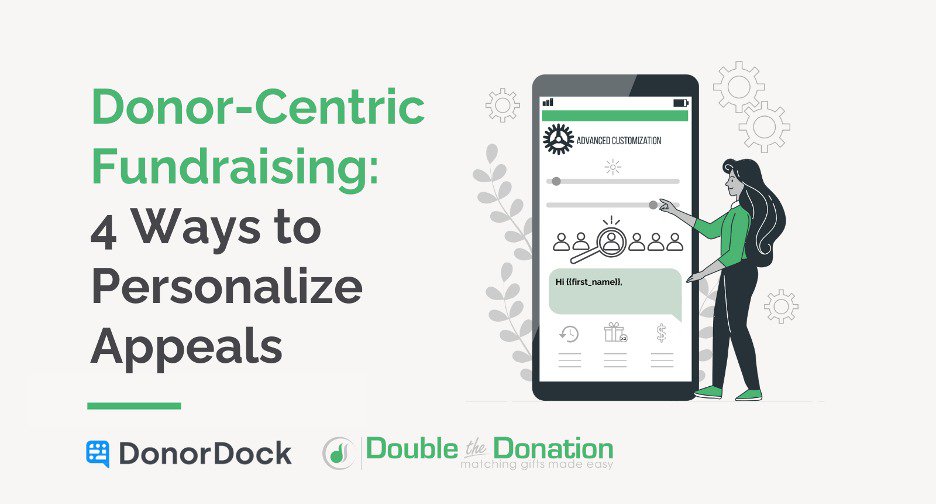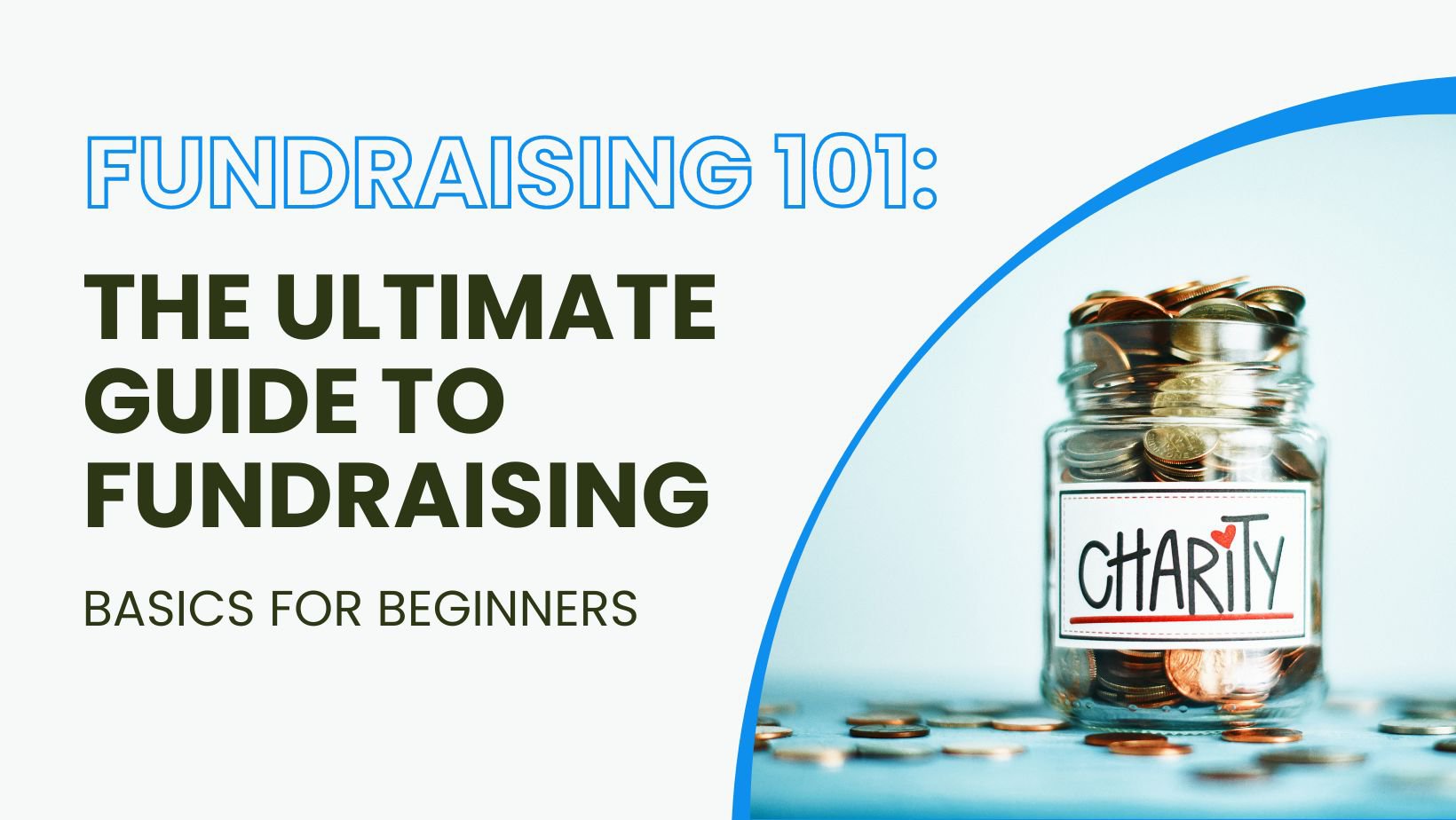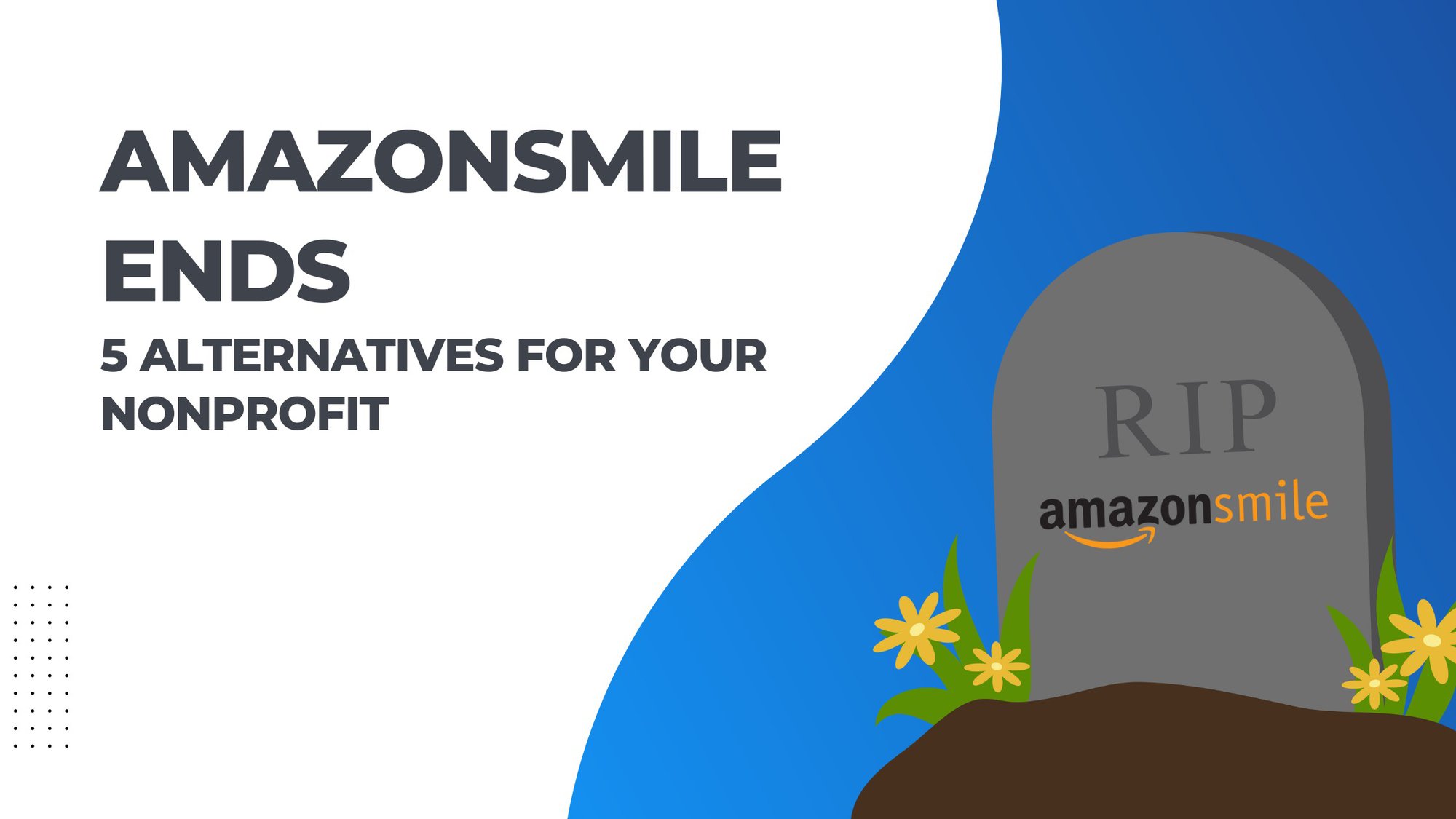Constituent management is a crucial aspect of any organization, particularly in the political and non-profit sectors. It involves the process of managing and tracking interactions with the individuals that an organization serves. This can include voters, donors, volunteers, and even employees. Effective constituent management allows organizations to build stronger relationships, understand their audience better, and ultimately, achieve their goals more efficiently. With the right strategies and tools, such as constituent management software, organizations can streamline their operations and ensure that every interaction counts.
In the nonprofit world, you wear a lot of hats! Yesterday, you were tackling donor outreach, tomorrow you’re planning an event, and right now, you’re trying to figure out the best way to manage your donors. This is where Constituent Relationship Management (CRM) comes into play. A nonprofit CRM helps your nonprofit track donations, store donor data, and track donor engagement.
With a well-designed nonprofit CRM, you have a full picture of what is happening within your organization. This empowers you to grow your donor base and connect meaningfully with your constituents which helps nonprofits increase donor engagement and retention.
So, let's dive deeper into what a Constituent Relationship Manager is and why it’s crucial for success.
Understanding Constituent Management Software
Constituent Management Software (CMS) is a vital tool for organizations that deal with a large number of constituents or stakeholders. It's a type of Customer Relationship Management (CRM) system specifically designed to manage, track, and improve interactions with constituents, whether they're donors, customers, volunteers, or members.
Key Features of Constituent Management Software
Constituent Management Software comes with a variety of features designed to streamline and enhance the management of constituents. These include:
- Data Management: CMS allows organizations to store and manage large volumes of constituent data in a centralized location. This includes contact information, interaction history, preferences, and more.
- Communication Tools: These tools enable organizations to communicate effectively with their constituents through various channels such as email, social media, and direct mail.
- Reporting and Analytics: CMS provides comprehensive reports and analytics to help organizations understand their constituents better and make data-driven decisions.
These features collectively help organizations to build stronger relationships with their constituents, leading to increased engagement, loyalty, and support.
The Importance of Constituent Management Software
Implementing a Constituent Management Software can bring numerous benefits to an organization. Some of the key advantages include:
- Improved Efficiency: By automating routine tasks, CMS can significantly reduce the time and effort required to manage constituents.
- Enhanced Communication: With CMS, organizations can communicate more effectively with their constituents, ensuring they receive the right message at the right time.
- Better Decision Making: The reporting and analytics features of CMS provide valuable insights that can inform strategic decisions.
By leveraging these benefits, organizations can not only improve their constituent management processes but also drive their overall success.
Understanding Constituent Relationship Management Databases
A Constituent Relationship Management (CRM) database is the nonprofit world's answer to traditional Customer Relationship Management. This type of database serves as a single source of truth for all your constituent data. This allows you to understand each individual relationship and have a holistic view of your donor base.
Customer Relationship Management vs. Constituent Relationship Management
In the dynamic world of relationship management, Constituent Relationship Management emerged as a tailored solution for nonprofits, born from the roots of its for-profit counterpart, Customer Relationship Management systems. While traditional CRMs are designed specifically for the for-profit world, nonprofit professionals recognized the need for a tool that could address the unique challenges they faced.
Customer Relationship Management systems, like Salesforce, serve as invaluable assets to businesses, finely tuned to optimize sales, marketing, and customer service operations. These platforms are equipped with a wide array of features, from lead tracking to sales forecasting, all geared toward growing profitability and operational efficiency. However, Salesforce wasn’t built with nonprofits in mind. For many nonprofits it’s like trying to fit a round peg in a square hole.
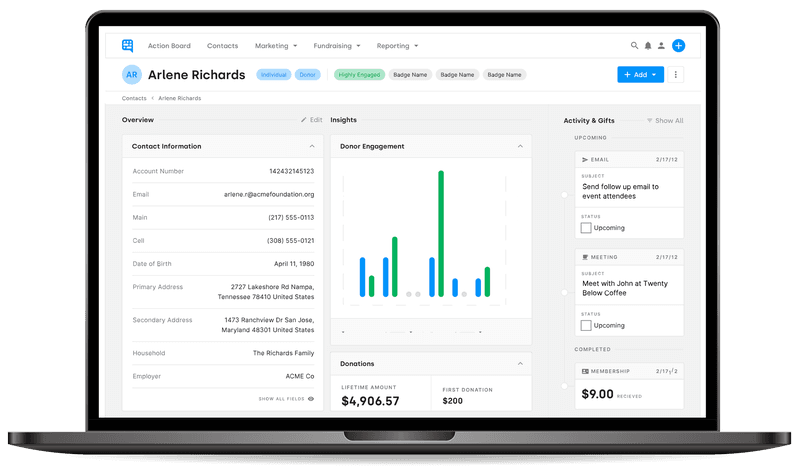
On the flip side, Constituent Relationship Management systems, like DonorDock, shine in the nonprofit sector, where their functionality is geared towards managing donor relationships, coordinating volunteers, and streamlining fundraising efforts. These tools play an essential role in mobilizing resources and support for meaningful, impactful missions, showcasing a dedicated focus on the distinct needs of nonprofits. In essence, nonprofit CRM systems are the result of recognizing and addressing the specific needs of a sector driven by a commitment to social good rather than monetary gain.
The role of CRM in nonprofits
A nonprofit CRM system can be a game-changer for any nonprofit. Imagine having all your constituent data at your fingertips - from major donors, volunteers, and event participants to ticket sales and gifts. All readily accessible with easy to understand reports.
A well-designed nonprofit CRM should function as a donor development platform, enabling you to not only connect but also foster meaningful relationships with your constituents.
With a nonprofit CRM, you can track donations, donor interactions, volunteer hours, membership data, and more. A nonprofit CRM is designed to simplify your donor management so you have a clear picture of what is happening with your donor base. It helps organizations make sure they're contacting the right people at the right time with personalized messaging, focusing on cultivating relationships rather than just fundraising capabilities.
What does this mean for nonprofits?
- You can understand shared characteristics among different constituents such as major donors or newsletter subscribers.
- You have quick access to essential information like past donations, involvement in previous campaigns, and attendance at events.
- Your staff members get an immediate overview of any individual's history without digging through multiple systems or sticky notes stuck around desks.
- You can effectively target constituents based on their interests, engagement level, and donation history – turning insights into action for social good.
A well-implemented CRM solution turns mountains of data into a valuable asset, helping you improve donor engagement while growing in fundraising sustainably.
A well-implemented CRM solution turns mountains of data into a valuable asset.
If you’re trying to find the right nonprofit CRM for your nonprofit, check our top 5 CRM picks for small to midsized nonprofits.

Why Nonprofits need a Constituent Relationship Management database
A Constituent Relationship Management (CRM) database is like the brain of any nonprofit organization. It's where all your vital information about donors, volunteers, and clients resides. But why do nonprofits need it?
The goal of CRM for nonprofits isn't just to store data - it's to make that data actionable. A well-maintained CRM helps retain existing donors, engage more effectively with volunteers, and streamline communication with supporters.
Beyond these critical functions, it also empowers organizations with insightful analytics. This data offers valuable insights into donor behavior, allowing nonprofits to fine-tune their outreach strategies and make data-driven decisions. You wouldn’t want to lose track of who attended last month’s fundraising event or a volunteer who committed to helping at an event. Likewise, you wouldn’t want to ask for a gift from a donor who just gave a week ago.
Having an organized constituent relationship management database lets you understand not only what happened in the past but understand what is currently happening within your nonprofit and plan for the future, too. This ensures that you’re using your time effectively, ultimately amplifying the impact of your mission.
A nonprofit CRM takes tasks off your plate
A constituent relationship management database designed with your nonprofit in mind should ease your mental load. Many nonprofit CRMs offer automation that helps with manual data entry workloads. With automated tools at your disposal, maintaining donor records becomes less cumbersome allowing staff members more time for their core duties.
Strategic use of your CRM aids in identifying potential major donors and knowing when to reach out to your constituents thus optimizing your online fundraising efforts.
Key Takeaway:
Your nonprofit CRM is the brain of your nonprofit, pulsing with vital information that helps streamline marketing efforts, lighten data entry tasks, and enhance fundraising by pinpointing possible donors. It's more than a storage unit—it’s a powerful tool to drive your organization forward.
Features & functions of a nonprofit CRM
A nonprofit CRM should be designed with the features your nonprofit needs to streamline and simplify your workload. Here are the features to look for, when picking a nonprofit CRM.
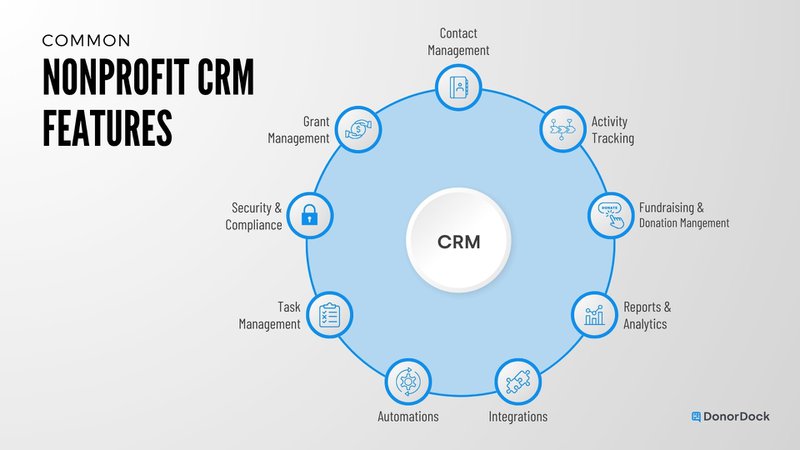
Donor Management:
It tracks and records interactions with donors, including donations, communications, and engagement history. This helps nonprofits understand donor behavior and preferences.
Contact Management:
It maintains a comprehensive database of contacts, including donors, volunteers, members, and other stakeholders. This includes their contact information, demographics, and communication preferences.
Online giving, Fundraising, and Donation Tracking:
It helps in managing fundraising campaigns, tracking donations, and generating reports on fundraising performance. This may include tools for online giving and event management.
Donor Outreach:
It often includes features for email marketing, text message outreach, newsletter distribution, and social media integration. This helps nonprofits stay in touch with their supporters and keep them informed about their activities.
Volunteer Management:
It allows nonprofits to track and manage volunteers. This helps in efficiently organizing volunteer efforts.
Reporting and Analytics:
It provides tools for generating reports and analyzing data related to fundraising efforts, donor behavior, campaign effectiveness, and more. This information helps in making data-driven decisions.
Grant Management:
Some CRMs include features for managing grants, including tracking applications, reporting requirements, and grant outcomes.
Member Management:
For organizations with membership models, the CRM may include features for managing memberships, renewals, and benefits.
Integration with other Tools:
A good nonprofit CRM integrates with other software solutions, such as accounting software, marketing platforms, and event management tools, to streamline operations.
Security and Compliance:
It should have robust security measures to ensure the safety and privacy of your nonprofit’s data.
ActionBoard:
A nonprofit CRM that is specifically designed to turn your data into actionable tasks will help you improve donor relationships. Getting Smart Nudge reminders to reach out to lapsed donors or constituents who haven’t heard from you in a while, simplifies donor engagement.
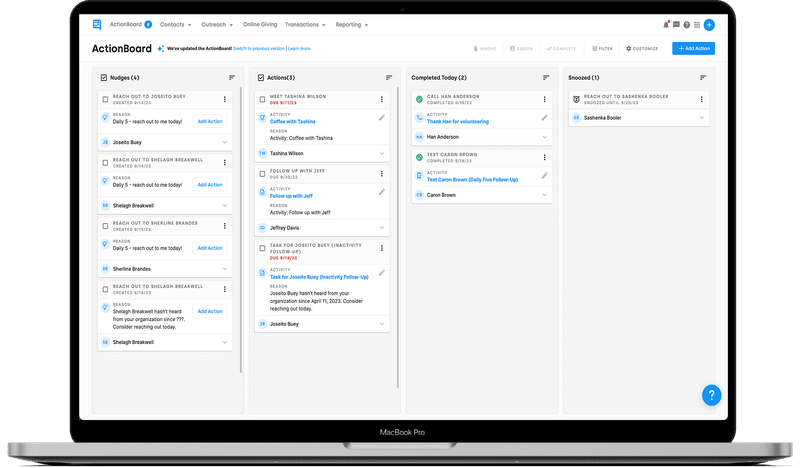
Integrating your nonprofit CRM
You know those moments when you're digging through multiple systems trying to piece together constituent data? Yeah, forget about them. The right Nonprofit CRM integrates with other solutions to ensure that each staff member has access to complete and up-to-date info at their fingertips.
Many nonprofit CRMs have integrated email marketing software and online giving pages. This simplifies workflows and keeps all data together in one place. Many nonprofit CRMs also connect with accounting platforms, project management tools, and other software your nonprofit may already be using. this seamless connection means all your data - from donor information to event participants’ details - lives in one place.
A comprehensive perspective allows you to make more intelligent decisions founded on live information instead of relying on intuition or presumptions. It also helps evolve relationship management strategies by providing insights into shared characteristics among your donors or volunteers.
- Data-informed decision-making: No need for crystal balls here – hard facts lead the way.
- Evolving strategies: By identifying trends and patterns in constituent behavior you can adapt our approaches accordingly.
Choosing a Nonprofit CRM Solution
The path to choosing the right nonprofit CRM solution can seem like navigating through an uncharted jungle. Let's break down how to find the best CRM for your nonprofit.

Your first step is discovery - identifying what you need from your constituent relationship management system. This could be anything from managing donor data to streamlining marketing campaigns or integrating accounting functions.
Be clear on what your nonprofit specifically needs and doesn’t need. This will help you narrow down solutions that are actually tailored to your nonprofit. Sure, there might be a nonprofit CRM that offers all the bells and whistles, but if your nonprofit just needs something simple, then you’re paying a premium for tools you’ll never use.
After you’ve figured out what you need, create a shortlist of potential solutions that meet these needs. It might be tempting to include every software under the sun here, but remember: focus on quality over quantity.
Make your scorecard
To help with evaluating options, make yourself a scorecard. List all essential features and functionalities you're looking for in your ideal nonprofit CRM solution on one side while noting each shortlisted option across the top.
While this doesn’t have to do with functionality, you should also include transparency and pricing in your scorecard. It’s unfortunately very common for some nonprofit CRMs to not be transparent with their pricing. Pricing information should be easily accessible on their website. Clarify if they charge for features like customer support, additional constituents, or other features you might expect to be included.
It’s also worth asking if they require you to sign a multi-year contract and keep note of that.
Schedule demos or free trials
Scheduling demos, yes plural, presents opportunities to see how each solution works in action. Take note of their ease of use, adaptability, and customer support during these sessions.
Some nonprofit CRMs are moving toward a more user-friendly approach that lets you try their product for free, without having to schedule a demo first. With these solutions, it is important to still schedule the free trial on your calendar, so that you are able to take the time to truly test it out.
Evaluating results comes next - time for those trusty scorecards again. Here’s where being nit-picky pays off as it helps narrow down choices even further.
Pitching selected options to board members will require condensing technical jargon into understandable benefits they can get behind.
Once approved by your team comes the implementation phase. Next, you’ll need to migrate your donor and gift data into the CRM. The onboarding phase might feel a bit daunting, but any CRM worth its salt will offer free customer support and onboarding support to make this process as smooth as possible for your nonprofit.
Remember: ‘going live’ isn’t crossing some imaginary finish line. It’s the start of a journey to better constituent relationship management. Trust me, it's worth every step.
Conclusion
You now know that a Constituent Relationship Management (CRM) system is not just a tool, but your guiding light in nurturing relationships within nonprofits.
A nonprofit CRM plays in critical role in managing contact information, event tracking, marketing automation, and more. This allows you to create personalized experiences - whether dealing with donors or volunteers.
Remember this: integrating CRM systems with other tools can take your nonprofit to new heights. By harnessing data-driven strategies like targeted communications and automated processes, you're well on your way to building stronger bonds with constituents.
In essence, navigating the complex ecosystem of relationship management becomes less daunting when armed with an effective CRM solution tailored for nonprofits.
Are you using a nonprofit CRM that fits your needs and serves up actionable steps to help you cultivate better donor relationships?
Nurture your donor relationships with DonorDock. An easy-to-use Donor Management Platform built for nonprofits like yours.
Constituent Relationship Management FAQs
What is constituent relationship management?
Constituent Relationship Management, or CRM, is a software nonprofits use to track and improve their relationships with donors, volunteers, and other stakeholders.
What is a constituent relationship?
A constituent relationship refers to the connection between a nonprofit organization and its key stakeholders - including donors, volunteers, clients - essentially anyone who interacts with the organization.
What is a constituent manager?
A Constituent Manager organizes all interactions that an individual has had with your nonprofit. They oversee tracking donations received from individuals or groups within the community.
Why should an organization consider moving to a constituent relationship management system?
Moving to a CRM system lets organizations manage stakeholder data more efficiently. It helps in better engagement planning and optimizing fundraising campaigns by making smarter data-informed decisions.




